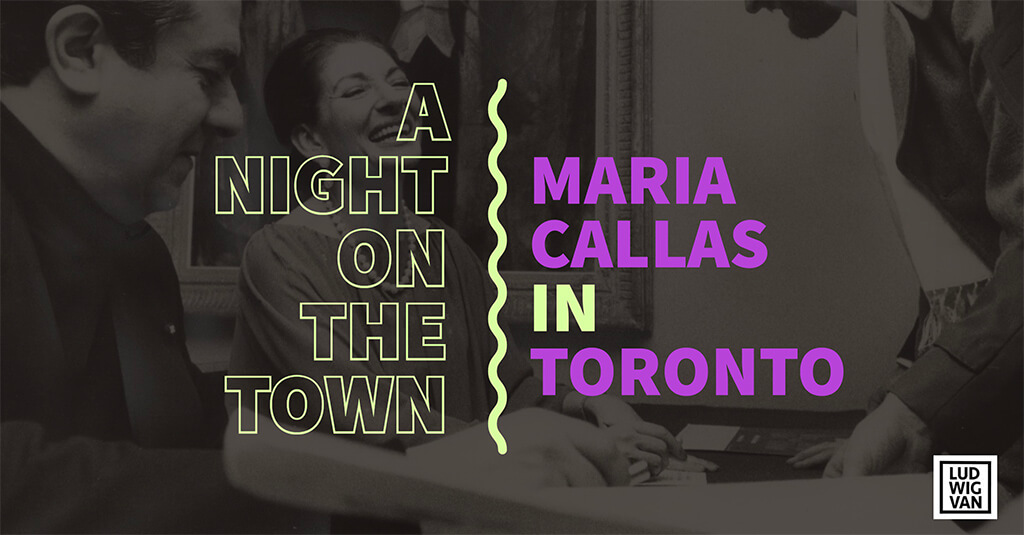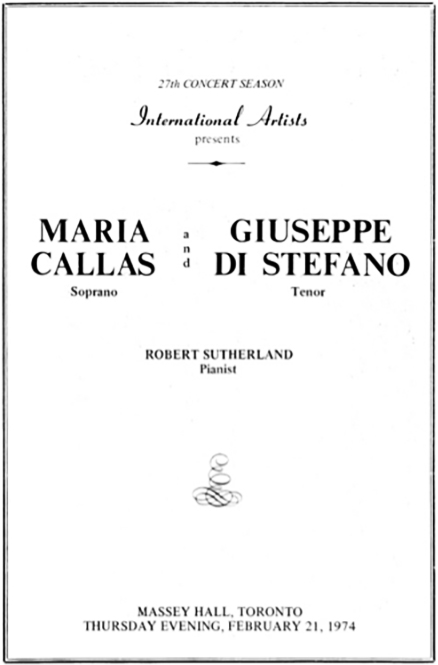
Maria Callas Is Coming!” trumpeted one newspaper headline a few days before the Greek-American soprano was to make her highly anticipated Toronto debut on October 21, 1958. Vocally, the diva was at the peak of her game, and the height of her celebrity, so it is not surprising that an estimated 5,000 to 6,000 opera fans gathered to hear her perform in the cavernous Maple Leaf Gardens – home not only to the Maple Leafs, but also to New York’s Metropolitan Opera on tour. So dense were the crowds of fans, the Toronto Daily Star reported, that when she appeared, police had to drive a path through the cheering throngs.
For her local debut, Callas offered up a generous and demanding programme of arias from Boito’s Mefistofele, Puccini’s La bohéme, Rossini’s Il barbiere di Siviglia, Spontini’s La Vestale, Thomas’ Hamlet, and Verdi’s Macbeth; while the Italian-American conductor, Nicola Rescigno, conducted an orchestra of 51 local Toronto musicians. Each selection was greeted with cheers and stomping feet.
A few years prior to this Toronto concert, Callas had undergone a period of dramatic weight loss. She was transformed from a heavy-set, awkward woman into a svelte, photogenic beauty gracing the cover of Vogue magazine. Torontonian Jean MacPhail — then a young woman obsessed with fashion — remembers the concert that evening as much for the many gowns that Callas wore as for her singing. “Yes, that,” she adds, “and those incredible, dramatic gestures she would make. Sensational!”
Although Callas was contracted to return to Toronto the following year to sing one of her signature roles — Puccini’s Tosca — the Met’s General Manager, Sir Rudolf Bing, in a much-publicized feud with the “tigress of grand opera”, fired her before the performance could take place. As a result, Torontonians had to wait 16 years to hear Callas again.
By the mid-60s, things had changed considerably for the soprano. Her voice was in a precarious state, and her relationship with her lover – shipping magnate, Aristotle Onassis — fraught with tension. This, coupled with poor health, caused her to cancel three of four Toscas at Covent Garden. Little did we know that the fourth Tosca, a gala performance for the royal family on July 5, 1965, would turn out to be her last staged opera, and her last public appearance as a singer for 8 years.
During this self-imposed retreat, Callas continued to work on her vocal technique, but she also began experimenting with film (starring in Pasolini’s Medea), teaching (giving master classes at Juilliard), and directing opera (mounting Verdi’s I Vespri Siciliani in Turin). But as Rescigno observed, “Maria needed music. She needed the stage.” And so, on October 1973, Callas — who was soon to turn 50 — embarked on an extensive, 40 concert world tour with her companion and colleague of many years, tenor Giuseppe Di Stefano. This much-anticipated tour was launched in Europe, went to the USA and Canada, and then eventually to Korea and Japan. While initially billed as Callas’ “comeback tour”, it quickly became evident that it was, in reality, her “farewell”.

When Callas and her entourage appeared in Toronto on February 21, 1974, her singing was but a shadow of what it once was. And as one patron put so succinctly: “She sang not so well; and not so much.” While another said simply, “I cringed”. Callas sang three solos that evening: “Suicidio” from La Gioconda, “Voi lo sapete, o mamma” from Cavalleria Rusticana (not listed in the programme), and “O mio babbino caro”from Gianni Schicchi; plus four duets with Di Stefano. As he was indisposed, the tenor sang only one solo. Accompanist Robert Sutherland, according to one source, fleshed out the evening with piano solos.
While the concert was not an artistic triumph, the audience remained faithful and cheered their support throughout. ” Initially we were all so excited,” says soprano Mary Lou Fallis. “After all, we were going to see the legendary Maria Callas. But as I left the hall, all I could feel was a deep, deep sadness.”
For one Callas fan, the concert remains vivid in his memory, even 40 years later. “I paid top dollar — then $25.00 — for a great seat ten rows from the front,” recalls David James (then a 27-year-old music student at the University of Toronto). “And when she entered she was in full sail with her chestnut-brown hair piled high, wearing a pinkish red gown. The audience went absolutely nuts before she had sung a note. She seemed genuinely overwhelmed by the reception.”
As for the concert itself, James admits that it was not without its shortcomings, but what shone through were her conviction, her integrity, her artistry. “Dramatically,” he says, “you couldn’t take your eyes off of her. You HAD to look at her. The programme was so intense. There was no let-up and she gave everything that she had. And while her top notes may have had that characteristic wobble, her voice was so incredibly powerful in the chest, that it made you shiver. “
“With Callas,” wrote critic, William Littler, in his Toronto Star review the following day, “one always tried to listen through the voice, to the dramatic truth it expressed.” But even that was not sufficient to save the day, as Callas’ voice had now become increasingly uneven and unpredictable. Perhaps it was foolish for her to undertake such a taxing tour, as there was no way that she could possibly compete with memories of her past glories. Any attempt to do so would be inevitably doomed to fail. For in reality, Callas was competing not with herself, but with a legend. The legend of Callas. The legend of La Divina.
PS: Maria Callas’ final concert on her world tour took place in Sapporo, Japan on November 11, 1974. The tour was to be followed up the following year by four staged performances of Puccini’s Tosca on November 22, 26, 29 and December 6, 1975. Callas cancelled.
![[from the collection of Neil Crory]](http://www.ludwig-van.com/toronto/wp-content/uploads/sites/2/2014/10/callas-purple-724x1024.jpg)
- THE VOICE | Renée Fleming Turns Gold at Roy Thomson Hall - November 7, 2015
- THE SCOOP | Glenn Gould: Celebrating Genius with Cupcakes - September 28, 2015
- SCRUTINY | The Rebirth of R. Murray Schafer’s Apocalypsis - June 30, 2015



